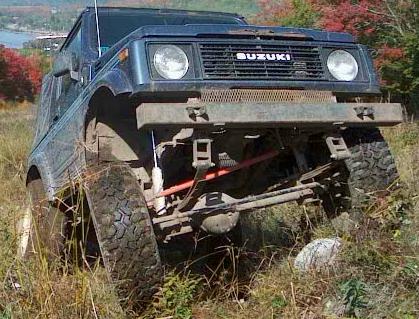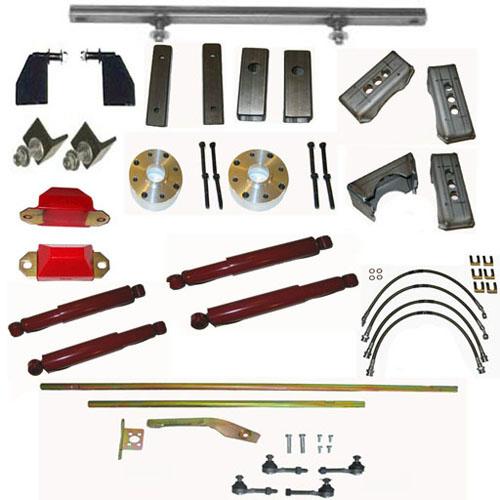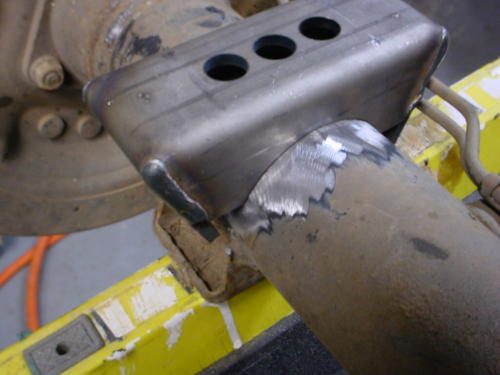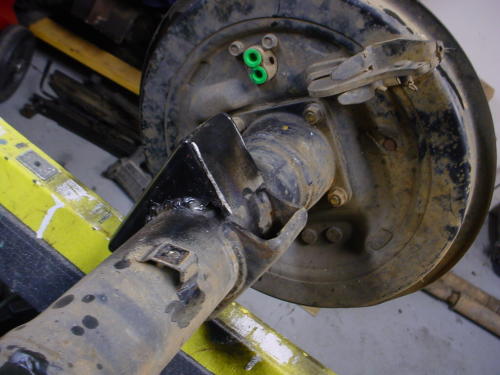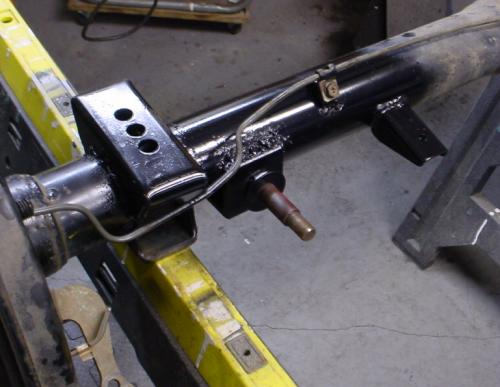This is not a step by step instruction guide to a Spring Over Axle conversion. This is basically an overview to let you know what is involved. Your SOA kit should come with detailed instructions.
A spring over axle (SOA) conversion is pretty straightforward with a few things to look for. The angle that the spring pads are mounted on the axle tube is very important. Improper driveshaft angles can cause vibration and reduce the life of your u-joints. If you’re adding additional lift (Example: Lift Springs) then you should really check to ensure you maintain the proper driveline angles. For more information on checking driveline angles, click HERE.
SOA Kits:
Companies like Petroworks offer these complete SOA kits.
Things You’ll Need:
SOA Kit
Welder
Grinder
Jack and jack stands
Large c-clamp
Brake fluid
Differential (gear) oil
Assorted metric sockets and wrenches
Disassembly Overview:
Remove all four wheels.
Remove all four shocks.
Remove the front and rear flexible brake lines.
Remove brake line clips from the flexible brake line connectors.
Plug the rigid brake lines where they’re open under the vehicle.
Disconnect and remove the emergency brake cable from each rear wheel.
Remove the front and rear drive shafts.
Drain the front and rear differentials.
Remove the stabilizer and stabilizer brackets.
Remove the steering damper.
Separate the pitman arm from the drag link.
Remove the nut and washer from the steering box shaft.
Using a puller, remove the Pitman arm from the steering box shaft.
Process:
Remove the inner shackle plate from the shackle. Lower each spring down clear of the axle. Remove the axle from under the vehicle. Remove the rigid metal brake lines from the axle.
Place the rear axle on jackstands. Weld the spring perches on the opposite side (top) of the axle tube. Make sure it’s directly lined up (centered) and parallel (even) with the bottom perch. You can make sure it’s even by measuring the distance between the new perch and old perch at each end and making sure the measurements are the same. If they’re not, the perches aren’t parallel.
These pics show the rear axle and brake lines. The brake line brackets must be moved around to make room for the new spring perches. The lower shock mounts must be tacked in place with the axle temporarily mounted and the shocks installed.
The front axle is similar to the rear, but you must pay close attention to the angle of the spring perches. They need to be parallel to the existing perches to maintain the proper steering angles.
You will need to either add a dropped pitman arm, or use a new drag link setup that relocates the drag link above the springs. If you don’t, you’re going to get ‘bump steer’.
Check your brake hose routing to ensure it’s not going to come in to contact with the tire.
The parking brake cable will be to short after doing a SOA. You can make an extension for the factory bracket if your SOA kit doesn’t already come with one.
Welding The Spring Perches:
Welding the perches on to the tubes should be done by a qualified welder.
Some people choose to set the new perches on the axle tube with the springs on the perches and the u-joints loose. They then rotate the axle to get the proper driveline angle and weld the perches in place.
Others simply calculate the angle the perches need to be and then weld them in place with the axle on jackstands.
Make sure you weld the perches in short sections pausing between welds so that you don’t transfer to much heat in to the axle tube and warp it.
Don’t Forget:
Don’t forget to refill the front and rear differentials using natural or synthetic SAE 80W-90, 75W-80 or 75W-90 hypoid gear oil (Suzuki “strongly recommends” the use of 75W-90 gear oil).
BLEED THE BRAKE SYSTEM! The Samurai uses a dual diagonal system, where the opposite front and rear wheels each use the same “main line”. This is different than most vehicles where the front and rear are isolated. Always bleed the wheel cylinder farthest from the master cylinder first. Be sure to keep the fluid reservoir on the master cylinder filled as you bleed the system.
Follow up on your work by rechecking all your bolts, nuts and torque settings and you’ve driven it a little to make sure everything is still tight.

